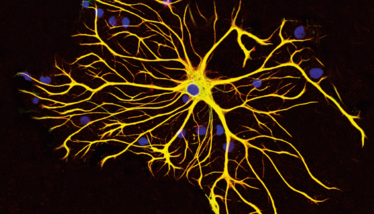THC on the Brain
How does THC cause changes in behavior? It’s more complicated (and fascinating) than we thought…

We already know that THC – along with most other psychoactive drugs – causes behavioral changes by interfering with the release of neurotransmitters (such as dopamine) from neurons in the brain. However, a paper published recently in Nature suggests that’s not the end of the story (1).
Previously, behavioral effects of THC were thought to arise exclusively from binding to CB1 receptors on the surface of neurons, causing them to release neurotransmitters. In the new study, researchers from Spain, France, and Germany identified an alternative mechanism, involving CB1 receptors in the mitochondria of neuronsupporting cells known as astrocytes.
Astrocyte mitochondria produce lactate, which is shuttled across to nearby neurons as an energy source. THC blocks the production of lactate in astrocytes and, without this fuel, neurons become stressed and may die.
To confirm their findings, the researchers injected THC-treated mice with lactate. Mice given THC tend to spend more time alone – when lactate was administered, their behavior returned to normal, proving that this pathway is responsible for some of the behavioral effects of THC in mice. If this turns out to be true in humans, it opens up a whole new avenue of research into how cannabinoids affect behavior.
In an accompanying Commentary article (2), neuroscientist Pierre Magistretti, who was not involved in the study, draws attention to the wider implications of the research, “Taken together, Jimenez-Blasco and colleagues’ observations highlight the importance of taking a broad view of how complex behaviours are regulated, beyond simple neuron-to-neuron communication [...] This exciting link is sure to be much studied in the future.”
- D Jimenez-Blasco et al., Nature, 583, 603 (2020). DOI: 10.1038/s41586-020-2470-y
- PJ Magistretti, Nature, 583, 526 (2020). DOI: 10.1038/d41586-020-01975-5

After studying biology at Imperial College London, I got my start in biomedical publishing as a commissioning editor for healthcare journals, and I’ve spent my career covering everything from early-stage research to clinical medicine. Attracted by the creativity, talent and passion of the team, I joined Texere Publishing in 2014, where I’m now Associate Content Director and Editor of The Cannabis Scientist.












